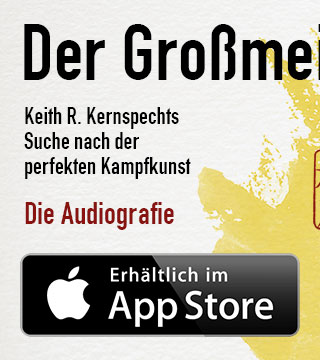The forms do not provide the letters, and Chi-Sao not only the glue
At a recent seminar in the Ruhr area, the best question of all came right at the end, when the open question-and-answer session had already come to a close and I was about to leave.
I had handed a 3rd TG two short knives and playfully demonstrated how one might improve one’s chances of survival by relying on anticipation based on experience and proper use of the tactile sense.
An instructor watched this for a while and put his question: "So why do we actually need the solo and partner forms?"
At first I did not understand the question, as my WT structure had to come from somewhere of course.
"Well," he said, "the movement you did just now, is it part of any of the forms?"
In saying so, he demonstrated the movement as he had seen me perform it.
And in fact it was not part of any form in precisely the way I had performed it, but similar nonetheless.
The questioner was a WT instructor, therefore he should have known that WT does not really have any "fixed techniques", or at least not where very advanced students are concerned. Everything happens on the spur of the moment, based on the interaction between the two antagonists. Wanting to "perform" a fixed technique makes us rigid and results in a bodged job. If you have a rigid resolve to follow a preset plan, you will become rigid! Someone who plans to fall asleep quickly will find himself still lying awake when morning comes. It is not for nothing that "wu wei" – unintentional actions – are trumps in WT!
The questioner was not only an advanced student, but also a very intelligent one, as his follow-up question revealed: "Yes, I fully understand that, but I always thought the forms provided the letters of the alphabet, which surely means that all WT movements should occur in the forms."
Now the scales fell from my eyes, and I recognised my shared responsibility for this rigid model of WT, which implies that we really should not perform any movement that is not contained in the forms!
I quickly corrected him, and possibly also the odd unthinkingly parroted statement I had myself made in the past: "The forms do not provide the letters. They are not the smallest structural element in WT."
The first form, during which only the arms may move, corresponds to a dictionary.
The second and third forms provide very brief sentences ("I see!", "Good afternoon!", "Help!"), the wooden dummy form slightly longer sentences
("Where is the bathroom?").
The partner forms (with contact) give us useful examples of sentences, e.g.:
"Has anybody seen my green book?", "The bakery will be open from 9 o’clock tomorrow."
Of course like all comparisons, this one is not quite apt; firstly because WingTsun is not a language, and secondly because movements are neither letters nor words.
Even Jesus only used allegories when speaking to laymen, but he expressed himself in clear when speaking to his disciples, i.e. the initiated.
Wrong analogies can lead to stupidity in the manner of a self-fulfilling prophecy. Not so long ago, when brain research was not yet a favourite scientific subject and little was known about the brain, it was compared to a vessel or container. When this container was full of information, it was believed that new knowledge could only be absorbed if old information was forgotten or deleted. An inappropriate comparison can therefore limit and stultify!
It was only the idea that the brain is a muscle which can be trained that produced the approach that existing knowledge is like a net which can collect further information, and becomes increasingly fine-meshed and
"containable" in the WingTsun sense.
Nowadays networked thinking is a commonly accepted term that encourages us to use our intellect and take on board the concept of enlightenment
(sapere aude).
Anybody who equates the Siu-Nim-Tao form with letters of an alphabet limits himself, and will stay at an eternal infant school level, still painstakingly copying down the standard alphabet, the letters his first teacher wrote on the board, when he has reached advanced age.
It is only the concept that the movements in the form are not the basic elements of WingTsun, but rather something that has been preformed and put together, that frees us and makes us capable of initiative.
But don’t take my word for it! How often have you heard and read Chinese masters say that in WT – and incidentally in all other inner systems as well – it is the so-called "principles" that count. And when they are right they are most definitely right, our antecedents!
Never lose sight of the fact that the strength of WT lies in not being a
technique-oriented style, but rather a concept-oriented system.
At this point let me also get rid of another erroneous idea which I myself entertained for years - without
being aware of the defining consequences:
If we see Chi-Sao merely as a bonding adhesive that connects the fixed techniques (which we fortunately do not have in WT anyway), or merely as a grammatical structure (to continue the WingTsun = language analogy), we are casting our self-imposed limitation in stone forever, as we are preventing our tactile sense from performing its quintessential task in WT, namely to generate appropriate (i.e. adapted) movements at the moment of interaction with an opponent. This means that we will have condemned ourselves to be eternal bodgers who are trying with all our might to apply a predetermined answer where it is not really appropriate. If the opponent asks us: "What’s the time?", the assiduously memorised answer "The bakery will be open from 9 o’clock tomorrow" will not really be suitable.
So give yourselves back your freedom:
Imagine your brain is a net of unlimited size that can take up all the more the more it already holds, and becomes increasingly densely meshed as a result.
Give pride of place to the adaptability of WingTsun, which comes from "real" feeling!
It is not for nothing that advanced students spend the majority of their learning time on Chi-Sao exercises! On the secure basis of Chi-Sao, which is intended to make us "unhittable", we then begin with "Lat-Sao", which makes our counter-attacks "unavoidable" for the opponent.
If it really were the case that we are slavishly bound to the limiting movements in the forms, we would be in a parlous state and I would have stopped doing WT thirty years ago. But fortunately there is Chi-Sao, which is not just the connecting glue and the grammar, but also allows what has never existed before to come about as if by itself.
It might be a good reality test for a WT school if a prospective student were to ask the presiding instructor:
"Do the forms provide the letters or the words here??
If the answer is "the letters", he is advised to back off as quickly as possible by
Your
Sifu Kernspecht
PS: Giving good advice is easy, but following it oneself is hard:
Last night at 1.30 am, I went to bed with the firm intention of going to sleep quickly, as I intended to return to Kiel early this morning.
Naturally I was unable to sleep; instead I wrote this editorial, because I fortunately failed to remember the best remedy for sleeplessness. I should have gone to bed with the firm resolve to stay awake!




